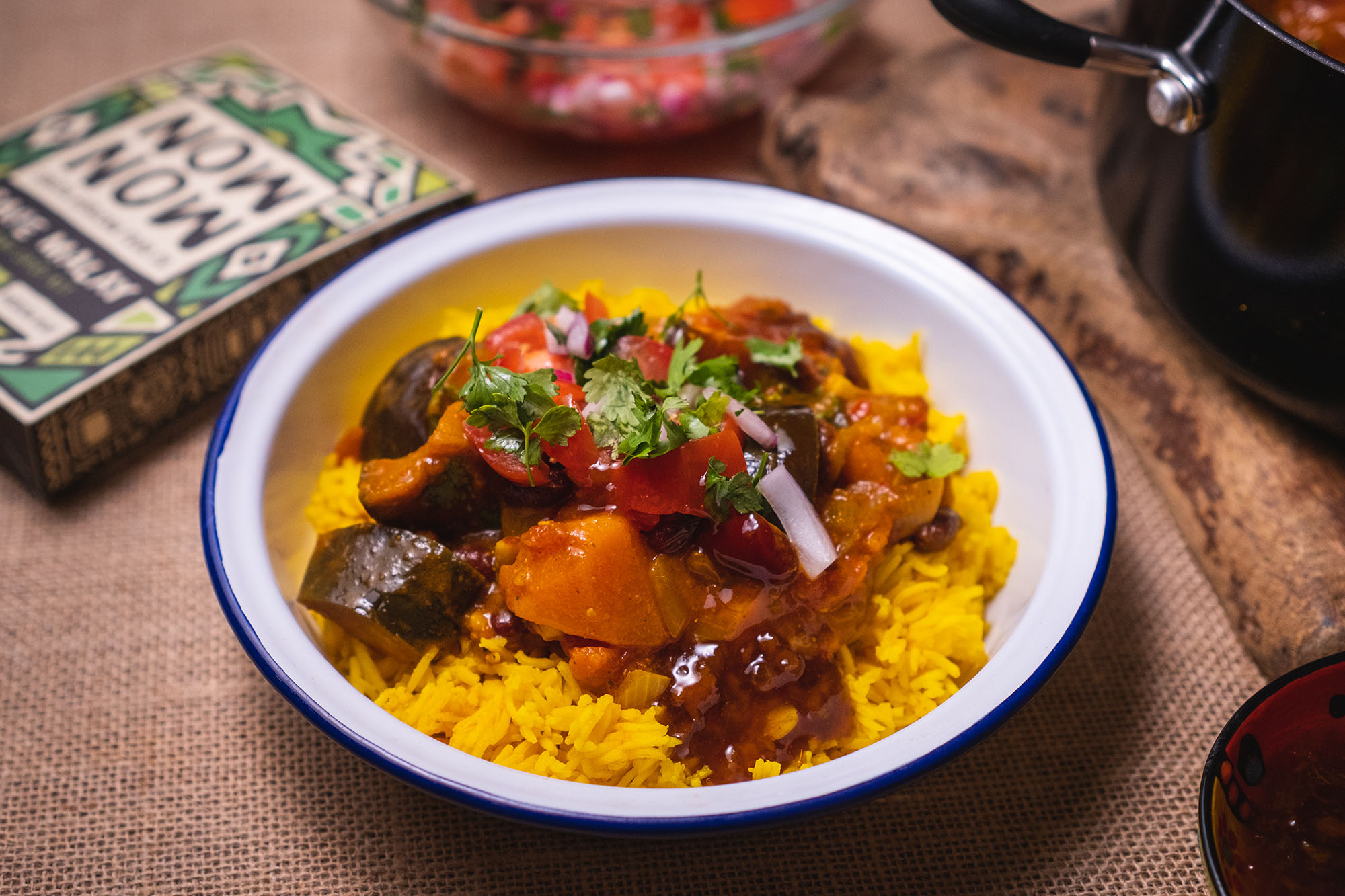Introduction
Research has shown that taste is the primary motivator for plant-based food purchases,1 and the good news is that the food produced by many plant-based brands is super tasty! But many consumers don’t yet know this.2 So how do you get a consumer to taste your product before they purchase it? Read on to discover five ways brands can leverage taste-based marketing. By the end of this piece you’ll know how to attract new consumers and drive mainstream sales of plant-based alternatives, using:
- Quick commerce
- Influencer giveaways
- Chefs and food services
- Food trucks
- In-store discounts
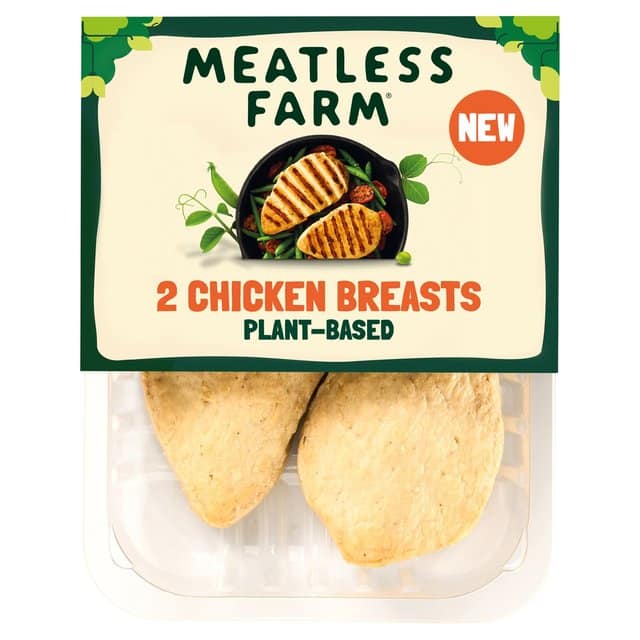
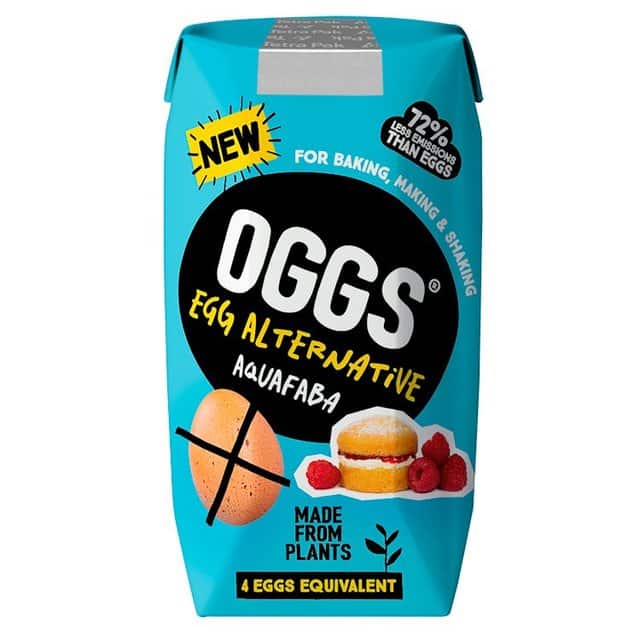
What came first, the ch*cken or the Ogg? The correct answer is: taste-based marketing.
The opportunity for plant-based brands has never been greater, with 40% of consumers worldwide actively reducing or fully avoiding the intake of animal-based products.3 Because consumers are primarily driven by taste4, plant-based brands need to win over their taste buds before winning over their wallets.
How I influence people is in cooked form… When I cook for people, they say, ‘if I could eat this way, I would be vegan.’”
Let’s kick off with one of the fastest-growing opportunities for plant-based brands: quick commerce.
1. Chefs and food services
Food service is a great taste-centred marketing strategy. Consumers are more likely to experiment with new flavours when dining out than when ordering delivery,5 and over half of Millennials believe that a new and unique dining experience is an important consideration when choosing where to eat.6 Together, these factors create a huge opportunity for plant-based brands to reach new consumers.
Having a food-service presence is a great way to build brand awareness. This demonstrable consumer base will help you pitch your product to new retailers, and will reinforce retail sales. As Nestlé’s executive team explains, “The lowest risk way to try a new plant-based product is [to sample it] in a restaurant or canteen. If you like it in one setting, you’re more likely to like it in the other.”7 That’s why Nestlé ensures that its Garden Gourmet range is available to both retail customers and food-service professionals.
The fact that the product is prepared by professional chefs means consumers don’t risk being put off by their own potential mis-preparation of the novel product — they’re getting the best possible experience right away, thereby promoting positive mental associations and engendering enduring confidence in the brand.
In this section, we’ll explore some of the different ways that brands are establishing their presence in the food-service sector.
Start by targeting independent chefs
According to Ankan Linden, founder of international plant-based brand Oumph! (SE), chefs are “the ones to persuade.” Numerous other professionals we spoke to share this view. “We like to enter markets through food service,” agrees Pascal Bieri, co-founder of Planted Foods (CH). “We want to create as many touchpoints with the consumer as possible. In Switzerland, Germany, Austria, and France we’ve seen this strategy work out well. We started out in restaurants, then Coop Switzerland [one of the country’s largest retail and wholesale companies] came knocking at our door.”
It’s wise to start by partnering with independent chefs. This is more time-consuming, but it allows your brand to learn from the way that chefs and consumers interact with your products, as well as ensuring your production can scale up with demand. For instance, Sugriv Gupta, co-founder of plant-based food brand ProMeat, targets independent chefs first, learns from customers’ responses, then moves on to targeting larger chains “so that more consumers get the opportunity to try it and get the best experience.”
If you want to make a headline splash, you can also target high-end indie chefs. “We partner up with great chefs,” explains Pascal Bieri, co-founder of Planted Foods (CH). For instance, they supply Tim Raue, a renowned chef in Germany who holds two Michelin stars. “He liked the product, and is cooking it in his restaurants now.”
Move on to restaurant chains
If your brand is targeting consumers in the Global North, then restaurant chains are a good prospect for you.
Case Study: Beyond Meat’s food-service strategy
Beyond Foods is an example of a plant-based brand that is really maximising its food-service presence through partnerships. Beyond’s products are sold in dishes at Pizza Hut, Starbucks, Denny’s, McDonalds, and other chains across Europe, the UK, and the US.
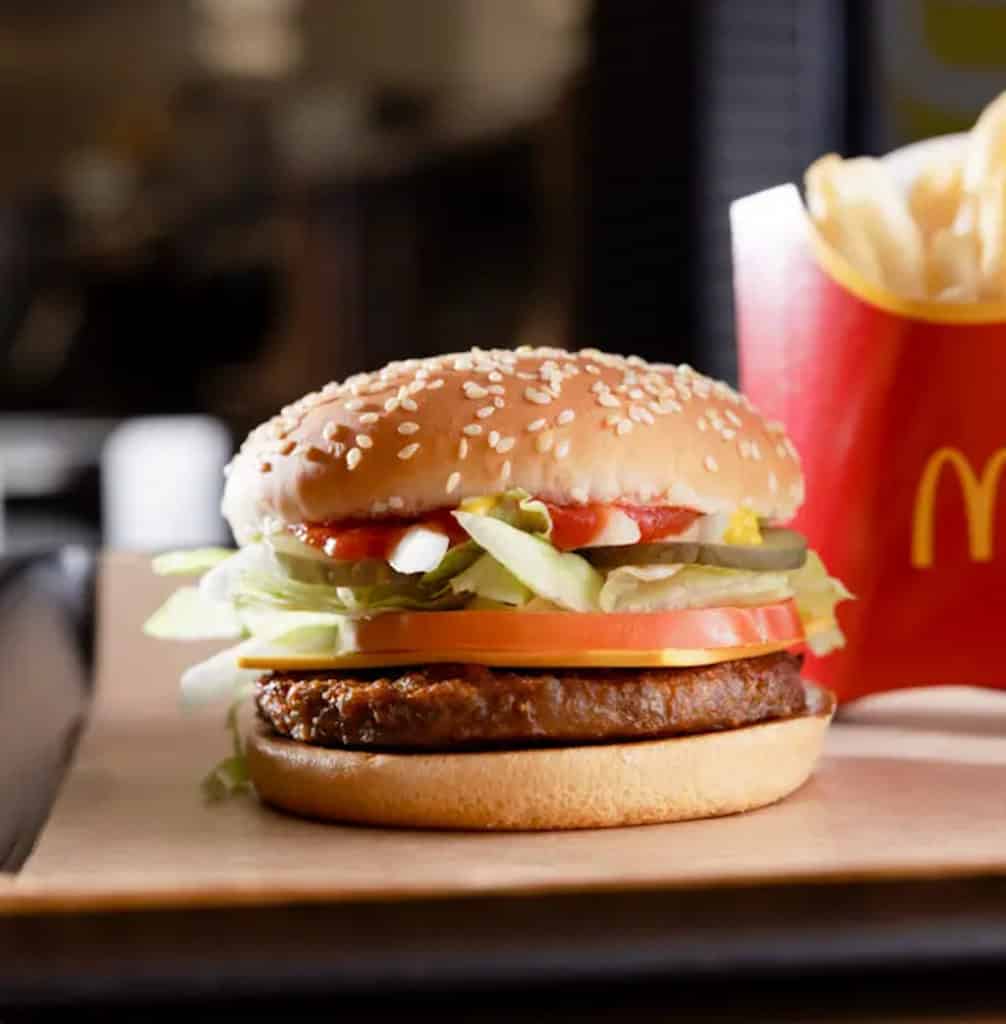
In 2021, Beyond Meat announced a three-year supplier agreement with McDonald’s. The fast-food giant began trialling its McPlant burger, made with Beyond patties, in locations across Europe and the UK. The product’s popularity has led to it becoming a permanent menu item. Subsequent US trials sold threefold better than expected, leading McDonald’s to roll out the burger across 600 more US stores from January 2022.8
Beyond’s products are also available in canteens in the US, thanks to a partnership with national food-services producer Aramark, who are aiming to make 30% of their dishes plant-based. That’s around 60 million meat-free meals per year in America’s school and hospital canteens.9
Helping canteens to go green will help your brand to grow
In the UK and Ireland, Sodexo is a major national food-services caterer. Plant-based brand Quorn partnered with them in 2021 to train Sodexo’s chefs in new ways to use their products.10 Following the partnership, Sodexo’s revamped vegan and vegetarian menus have grown in popularity, rising from 7% in 2020 to 13% of all meals sold by the end of 2021. The proportion of those meat-free meals which were fully vegan also doubled in that time. Quorn’s partnership neatly complements Sodexo’s aim to be at least 33% plant-based by 2025 as part of the caterer’s net-zero targets.11 By targeting food services with similar net-zero goals, plant-based brands can offer food-service clients great-tasting products with unique environmental benefits.

Actions for brands:
- Start by partnering with independent chefs — learn how they prepare and serve your products, look at how consumers respond, and ensure you’re ready to scale up production.
- If your product requires specific preparation, then offer free training sessions for teams of chefs in order to help them reinvigorate their menus with your plant-based alternatives.
- Approach restaurant chains and food services to maximise the number of product touch points – you want to be in cafés and restaurants, as well as in canteens at hospitals, universities, schools, and governments.
- National chains generally have net-zero commitments, so be sure to present your plant-based alternative as a delicious contribution to their emissions-reduction strategy.
2. Influencer giveaways
Consumers don’t always have to be the ones doing the tasting in order for taste marketing to be effective. A trusted endorsement can give them the social proof they need to make a purchase. This is where influencers come in – If they taste your product and share that positive experience with their fans, then one bite can become amplified to reach thousands of mouths. Let’s take a closer look at how this works.
Influencers are a great way to reach younger consumers without breaking the bank. Almost half (44%) of Generation Z has made a purchase decision based on a recommendation from a social influencer, compared with 26% of the general population.12 Furthermore, Millennials and Gen Z consumers trust influencers twice as much as they trust friends and family for recommendations.13 If you want to reach these consumers (which you should, because they’re the most open to plant-based alternatives), then consider influencer marketing.
Silk Almond Milk found that organic (i.e. unpaid) posts from influencers generated 11 times more engagement than their in-house posts. This translated into real sales: households exposed to influencer marketing purchased 10% more Silk products than the control group, with every 1,000 people who viewed influencer marketing generating a further $285 worth of sales of Silk products, compared to the control group.14
Heura is a popular Spanish plant-based-meat brand that’s built an audience of more than 160k followers on Instagram since 2017. The brand positions their product as part of a lifestyle movement and invites both followers and influencers to become ‘good rebels’ with them. In Spain, they started out befriending indie restaurants and food trucks. They knew their fellow foodies would become natural brand champions, since they’re motivated by the same goal (great quality food), not just financial compensation. The strategy is clearly working – they’ve been Europe’s fastest-growing plant-meat start-up for the past three years, growing a whopping 450% in 2020, and tripling their revenue to $10m. This has also enabled them to save a quarter of a million animals in that time.1516 The environmental and animal-welfare benefits are strong purchasing motivators for around two-thirds of flexitarian consumers, making these metrics significant reputation boosters for a plant-based brand.17
Heura’s influencer strategy helped them to leapfrog from small eateries to major restaurant chains across Spain, and, from there, into wholesalers and retailers. In 2020, they entered the UK market, where influencers are once again playing a crucial role in their growth. They partnered with indie chefs and restaurants to build a domestic consumer base, and, in early 2022, began their first UK retail partnership, with national e-grocer Ocado.
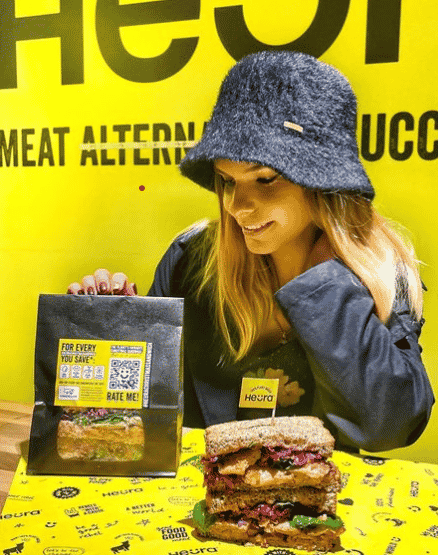
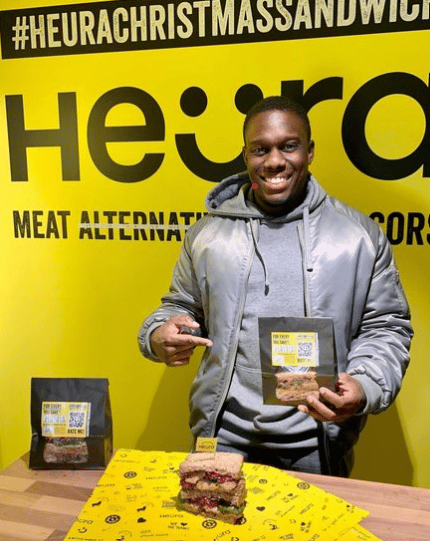
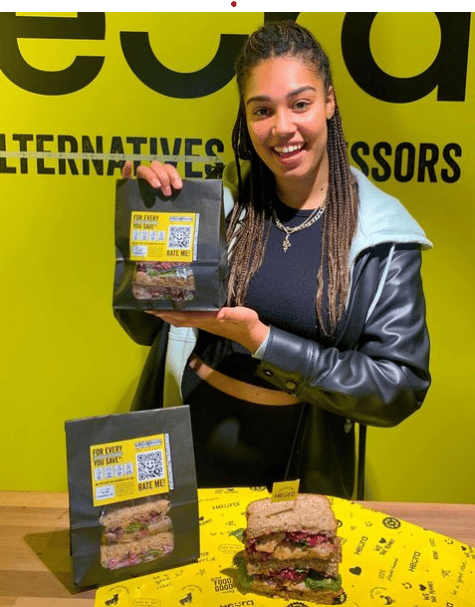
Heura has built a strong community of ‘good rebels’, as they call them, including powerful organic influencer relationships, which has helped them go from food trucks to restaurants and retail. From right to left: @thelittlelondonvegan, @dannylonglegz, @ella__vegan
Are you unsure how to build a relationship with influencers? Don’t worry – ProVeg has you covered. Check out our in-depth guide for plant-based brands and retailers: How to work with influencers to reach key consumers.

Actions for brands:
- Don’t pay influencers upfront. Instead, offer them free products to try. Your goal is for them to share their incredible tasting experience with their followers, and thus grow your audience.
- Build relationships with influencers who are aligned with your brand values and have a flexitarian following. Satisfy the right influencers’ taste buds and you can win over thousands of other target diners.
- If influencers tell you (and their fans) that they really love your product, then build on the momentum. Invite the influencer to do a giveaway competition for their followers, using free products that you supply.
- Remember, you don’t have to pay influencers for this kind of exposure. Their endorsement is generally much more powerful when it’s unpaid. For a detailed guide on this topic, check out our guide: How to work with influencers to reach key consumers.
3. Quick commerce
How is this taste marketing?
OK, it’s not as conventional as the other methods, but, for new brands and products, quick commerce can be a super-fast way to get your product in front of paying customers that you can’t yet reach through conventional retail channels. It’s a low-hassle way for them to try your product, often with a discount. Read on to see how it works!
What is the Q-commerce opportunity?
Quick commerce (Q-commerce) is when small grocery orders are placed and delivered within 10-20 minutes. In 2020, the market across Europe, the US, and China, was worth $25 billion (USD). This is forecast to almost triple to $75 billion in 2025, with the sector growing worldwide.18 Two Q-commerce companies – Getir (Turkey) and Gorillas (Germany) – became unicorns in 2021, both being valued at over $1 billion.19 Given that urbanisation is increasing globally, and that 78% of Western Europeans live in urban areas, the addressable retail market is huge.20 By pairing with a quick-commerce provider, you can help your brand to reach receptive consumers and early adopters.
Which providers should you partner with?
But who should you pair with? Older Q-commerce providers such as Uber Eats and Deliveroo partner with conventional food retailers to help those retailers retain market share by serving consumers who prefer to shop through new platforms. Newer Q-commerce providers such as Zapp, Cajoo, and Gorillas have their own warehouses in the cities they serve. They stock products based on each neighbourhood’s specific preferences.21 This means that brands can pitch their products to Q-commerce providers directly, retaining more of their margin, and potentially reaching new consumers much more quickly than conventional supermarket applications.

Tasting is believing.
We recently struck a new partnership with Gorillas. This gave us the chance to offer customers 50% off. Our product is now accessible to everyone in Germany and it gets delivered to their doorsteps – super convenient. We take the 50% hit because we know our taste will convince people to buy our product again. Quick commerce greatly helps people try our food.”

ProVeg Tips
Plant-based brand Planty of Meat is a graduate of the ProVeg Incubator. If you have a great concept for a plant-based alternative and want to get it off the ground, then join the dozens of companies who have benefited from ProVeg’s expertise and investment. Find out more on the ProVeg Incubator site.
Which demographics can you reach?
Q-commerce is particularly useful for increasing brand exposure among younger consumers (Gen Z and Millennials) — which is ideal for plant-based brands, as these demographics have the highest rates of people following a flexitarian/reducetarian lifestyle.22
“Young people, in particular, are embracing quick commerce like Go Puff, Gorilla, etc, and our product performs really well there,” explains Pepe Biaggio, co-founder of Pink Albatross plant-based ice cream (ES). “Consumers on those platforms are extremely keen to try new things, and, because they’re younger than average consumers, they’re also very environmentally conscious. We also stand out massively against the established brands. We differentiate through our flavour panel – instead of vanilla, chocolate, strawberry, we launched artisanal flavours like hazelnut, pistachio, coconut, mango and passion fruit, the sorts of flavours the big providers aren’t offering and which consumers aren’t used to finding in retailers.”
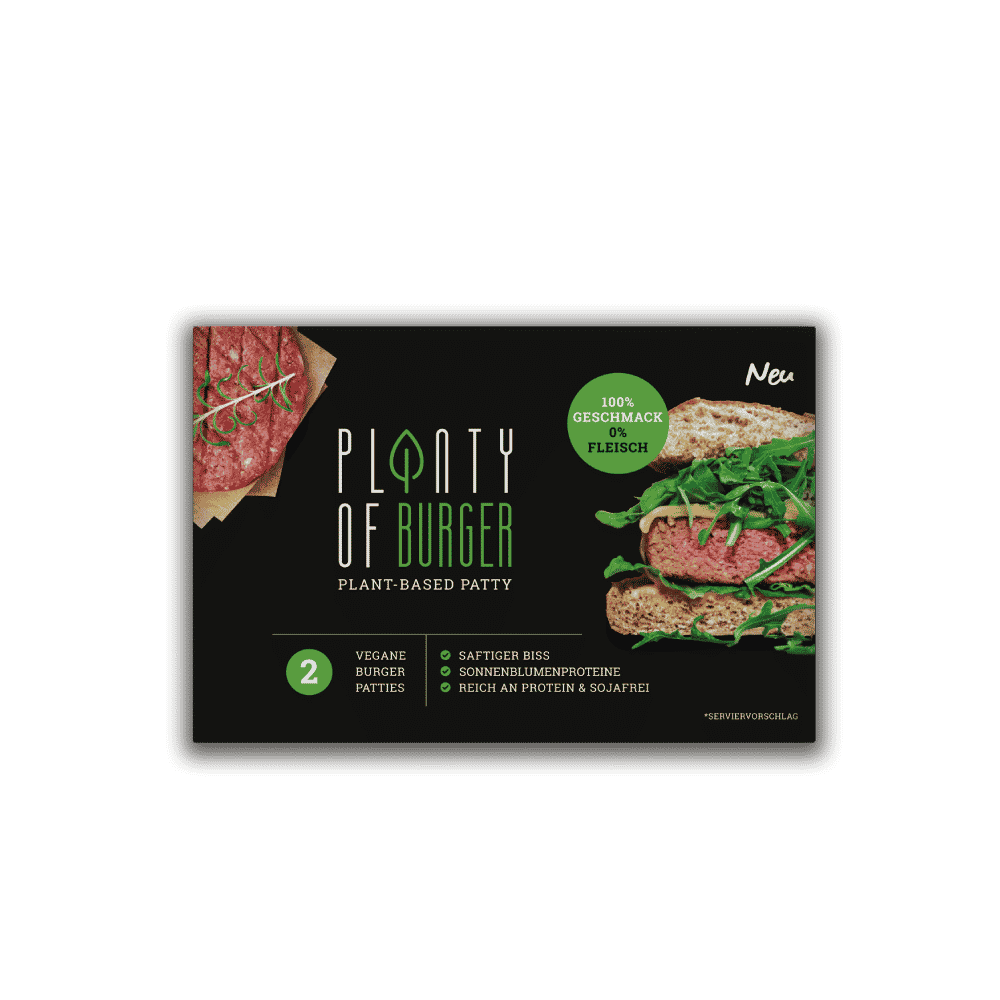
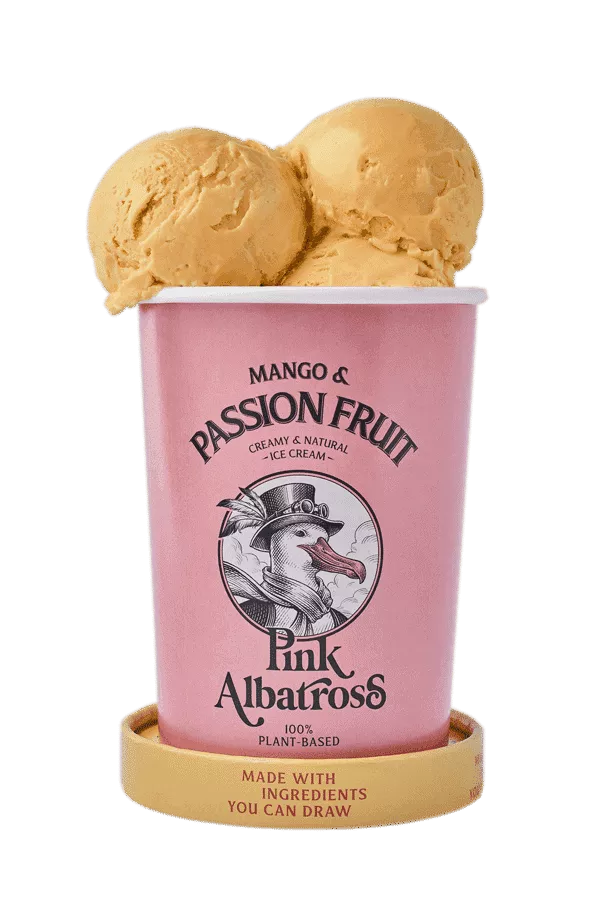
Available in 10 minutes. Quick commerce can help plant-based brands to reach the growing market of younger flexitarians.
Partnering with hyper-local platforms isn’t the only way to embrace Q-commerce, though. Hybrid arrangements are also emerging. For instance, Uber Eats, a collection service, partnered with Q-commerce platform GoPuff, which has its own micro-warehouses, to offer Uber customers access to GoPuff’s catalogue through the Uber app. In 2021, Uber Eats also partnered with beauty brand Estée Lauder to offer beauty products in select US locations.23 For more established plant-based brands with a retail or warehouse presence, you could potentially strike a direct deal with older Q-commerce providers too.
How else can Q-commerce increase consumer taste opportunities?
Q-commerce offers two ways to reach consumers with your product — as a retail product, or as a food service. For instance, in late 2021, plant-based brand Impossible Foods launched Impossible Shop — their new delivery-only restaurant brand, available in the US through Q-commerce providers DoorDash, Uber Eats, and Grubhub.24 It’s actually a ghost kitchen (also known as a dark kitchen) – in order to provide hot meals across multiple US States, Impossible partnered with national hot-dog eatery Dog Haus for the food preparation.25 (The branding is exclusively Impossible, though.) By combining ghost kitchens with Q-commerce, Impossible has dramatically increased its number of taste touch points for consumers across the US.

Actions for brands:
- Partner with a hyperlocal quick-commerce provider – the newer providers have their own warehouses, meaning that you can pitch your product directly to them and keep more of your margin. This, in turn, makes it easier for you to run promotional discounts to attract new consumers.
- Partner with a ghost kitchen provider and a quick-commerce provider to make your product available to consumers as a delicious, quickly delivered meal.
4. Food trucks
Free food that is well prepared attracts new consumers and gets them to like you. Multiple studies have found that the majority of consumers (about 75%) who receive freebies go on to remember the brand name and hold a positive association with that company.26 This lowers the consumer barrier to repurchase. A study of wineries by Cornell University found that when consumers had a great free-tasting experience, it led to them spending a further $10 with that brand, and a 92% likelihood that they would become repeat customers.27
A great way to raise your profile is by going direct to wherever your target consumers are – and offering free tastings to them in situ. “We go out with food trucks to create buzz,” explains Ankan Linden of Oumph!.
“We go around Germany giving products away for free,” agrees Planty of Meat’s Alexander Eder . “We organise free vegan cooking sessions, and we attend food conferences, which are typically 70% flexitarians. We also do free food-truck tastings in front of supermarkets when they launch us.”
Case Study: Good Catch uses food trucks to lure Subway customers
In June 2021, vegan seafood brand Good Catch pulled off an audacious publicity stunt. Capitalising on heightened public awareness of overfishing following the release of the documentary Seaspiracy, the brand parked its food trucks outside Subway branches in New York, Texas, and London. They offered passers-by free tuna subs that contained their Good Catch filling — a fish-free alternative made from blended plant proteins.28
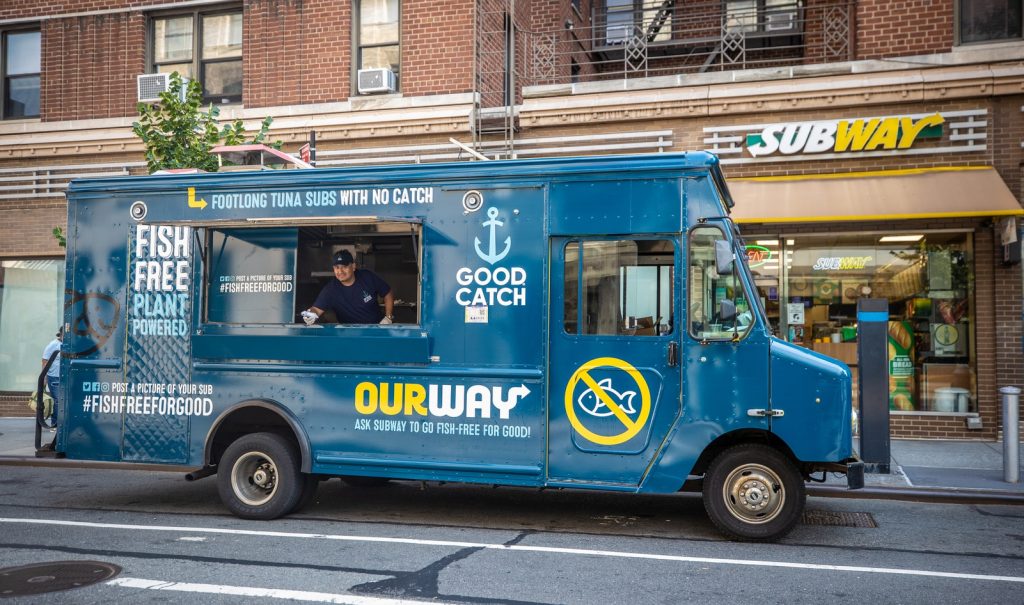
Good Catch gives away free, footlong, tuna-alternative subs with “no catch”. Anyone who offers great food and great puns gets our vote.
The stunt raised consumer awareness of the Good Catch brand internationally and helped the company to secure a partnership with Long John Silver’s the following month, granting them access to more consumers through the US’s largest fast-food seafood chain.29 Both of these activities created taste-marketing opportunities for consumers to try the alternative products in familiar settings, thus driving repurchasing behaviour in order to grow the brand’s early-stage, direct-to-consumer platform.30
Food trucks are a great investment (regardless of whether you buy one or hire one) — assuming you pick a high-footfall location. Be sure to get permission from the land owner and authorities in advance, and make sure that your chosen date won’t clash with any major events that could detract from your presence.
VFC (Vegan Fried Chick*n) timed their free-giveaway food van to coincide with Veganuary campaigns in early 2022. They popped up outside the busy King’s Cross St Pancras train station in London with distinctive branding and a clear value proposition. Crucially, it drew in flexitarian passers-by, including the food blogger quoted in the caption below.
VFC’s use of their food truck helps raise awareness of their brand, build consumer trust (through a great taste experience), and thus drive sales at their established national and regional retail and
restaurant locations. By augmenting their high-quality product with iconic branding and taste-marketing campaigns, VFC has grown prolifically since its UK launch in December 2021 — expanding to sell in the Netherlands and the US in under 18 months.
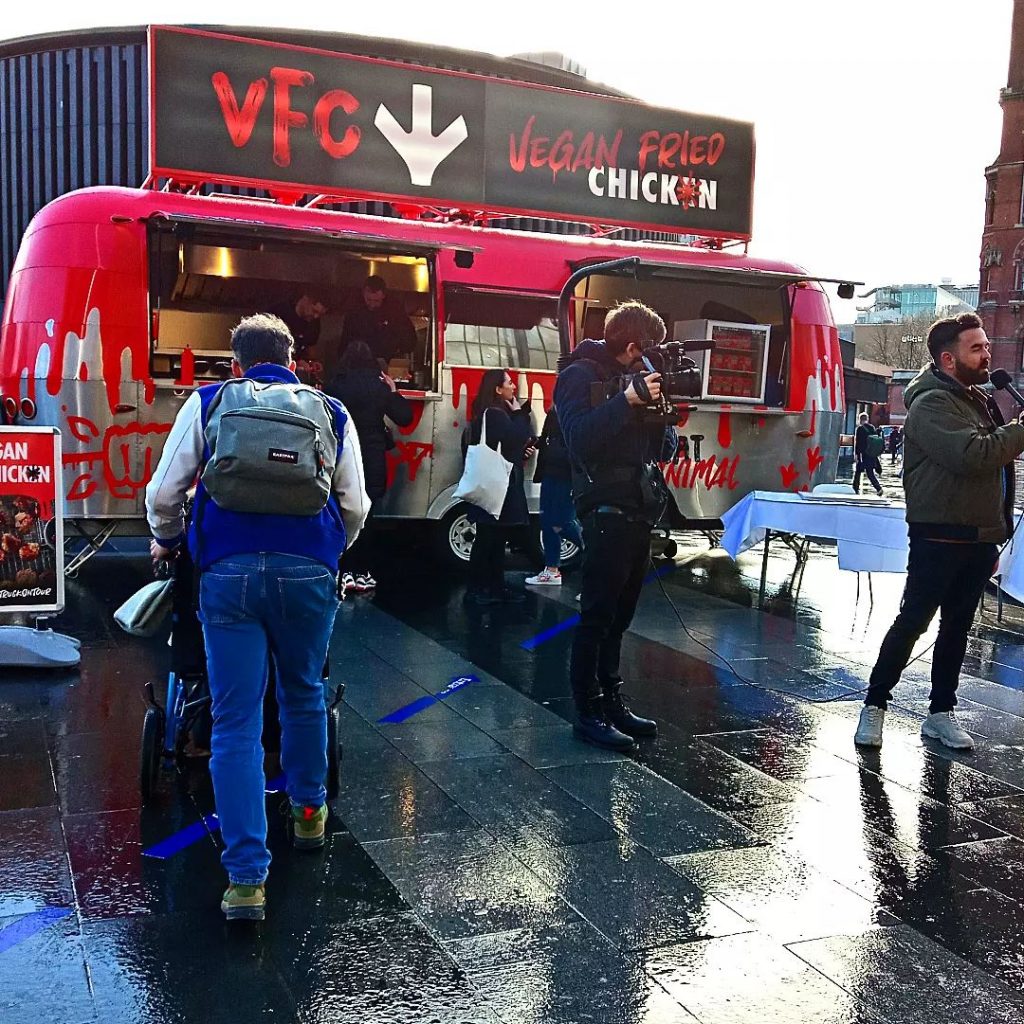
“The texture was really impressive because it was soft with a great meaty texture without being too dry.” — flexitarian passer-by who happened to be the food blogger behind Supersupergirl’s dining reviews.31

Actions for brands:
Invest in touring with food trucks that you own or hire in order to raise awareness of your brand and give consumers a great taste experience. Be sure to choose high-footfall locations and clash-free dates.
5. Discounts and freebies
At the beginning of this article, we established that taste is the top consumer motivator. It won’t come as a surprise to hear that the second one is price! This means that discounting is a great way to attract consumers and unlock their primary motivation. By lowering the price barrier, you can make it easier for consumers to taste your product, and thus win them over.
To entice [new consumers], plant-based products need long-term retailer price discounts to allow people to get used to the taste and texture.”
The great news is that retailers love it when brands offer discounts – and they’ll often help promote your products, especially if you give them exclusivity for a time. “We believe in hard discounts,” says Wim van den Burg, Team Lead Category Management Diner at Coop NL. “We were the first Dutch retailer to do this for plant-based products, and our veggie discounts are now the biggest ones Coop runs.” By way of example, Van den Burg notes that during the Netherland’s annual Week Without Meat campaign in March, they sell all Vivera products for one euro. This is a substantially bigger price drop than the previous market norm of a 25% discount. “The best way to help consumers embrace new routines is to offer a discount so they can experience it for a lower price. If the taste is good, then they’re more likely to maintain that new routine,” van den Burg adds.
Other retailers establish partnerships with brands in order to offer long-term discounts. For instance, Carrefour Belgium does a 10% loyalty-card discount on plant-based purchases every Monday, while Co-op and Tesco UK have unveiled entire own-label ranges that are permanently at price parity with conventional products (which is effectively a permanent discount, compared to historic market practices).

Consumers are motivated by taste and familiarity.32 Give them a bite for free and they’ll be ready to pay for more…
Of course, discounting is harder for smaller brands to sustain. If major-retailer discounts or freebie coupons are currently out of reach, remember that quick commerce offers brands a way to be stocked in smaller regions, targets a more flexi-minded audience, and sacrifices less margin than conventional retail discounting requires.
It’s essential to note that your discount will still only work if your packaging is enticing and oozes indulgence. At the end of the day, everything you do needs to appeal to consumers’ desires for a great taste experience. “It needs to be centred on the hedonic consumer experience,” explains Armando Perez-Cueto, Professor of Food, Nutrition, and Culinary Science at Umeå University, Sweden. “That’s reflected in our survey data. Tell consumers what they’re going to experience — focus on sensual properties, specific flavours, how they’ll feel.”
Are your product’s packaging and marketing hitting those hedonistic notes? Check out the competition, and industry-leading insights in our detailed guide: ‘5 marketing fails to avoid with plant-based products’.

Actions for brands:
- If possible, offer regular and sustained discounts to entice new flexitarian consumers to try your products. If you’re doing a pop-up food truck, that’s a great place to seal the deal with freebie coupons in order to really cement the new consumer habit of enjoying and buying your product.
- Partner with retailers to ensure that your promotions are advertised to their customers prominently in-store and online. If you can’t afford long-term retailer discounts, remember that quick-commerce can offer a cheaper, more targeted opportunity.
Conclusion
In order to attract flexitarian consumers to your plant-based brand, taste-based marketing is essential. ProVeg recommends the following best-practice strategies:
1. Use quick commerce:
- Partner with a hyperlocal quick-commerce provider – the newer providers have their own warehouses, meaning that you can pitch your product directly to them and keep more of your margin. This, in turn, makes it easier for you to run promotional discounts to attract new consumers.
- Partner with a ghost kitchen provider and a quick-commerce provider to make your product available to consumers as a delicious, quickly delivered meal.
2. Work with influencers:
- Build relationships with influencers who are aligned with your brand values and have a flexitarian following. Offer them free products to try, and if they like them, offer them free products to give away to their followers. (You don’t have to pay influencers for this kind of exposure — for more details, check out our guide: How to work with influencers to reach key consumers.)
3. Partner with chefs and food services
- Start by partnering with independent chefs — learn how they prepare and serve your products, look at how consumers respond, and ensure that you’re ready to scale production.
- If your product requires specific preparation, then offer free training sessions for teams of chefs to help them reinvigorate their menus with your plant-based alternatives.
- Approach restaurant chains and food-service companies in order to maximise the number of touch points that consumers have for your products – you want to be in cafés and restaurants, as well as in canteens at hospitals, universities, schools, and governments.
- National chains generally have net-zero commitments, so be sure to present your plant-based alternative as a delicious contribution to their emission-reduction strategy.
4. Food trucks and pop-up giveaways
- Invest in touring with food trucks that you own or hire in order to raise awareness of your brand and give consumers a great taste experience. Be sure to choose high-footfall locations and clash-free dates.
5. Offer discounts and freebies
- If possible, offer regular and sustained discounts in order to entice new flexitarian consumers to try your products. If you’re doing a pop-up food truck, that’s a great place to seal the deal with freebie coupons to really cement the new consumer habit of enjoying and buying your product.
- Partner with retailers to ensure that your promotions are advertised to their customers prominently in-store and online. If you can’t afford long-term retailer discounts, remember quick-commerce can offer a cheaper, more targeted opportunity.

ProVeg Tips
As a leading NGO in the alternative-protein space, we provide objective expert advice to food-industry professionals. We can help you to harness the power and profitability of plant-based eating through product-testing consultancy, marketing advice, and our extensive B2B network of suppliers, manufacturers, and retailers. To find out how we can help your brand, drop us a line at [email protected].
Note: ProVeg conducts exclusive interviews with a wide range of industry professionals for its New Food Hub white papers. Unless an alternative citation is provided, quotations are from those interviews. Some interviewees wished to remain anonymous.
References
- Parry, J., & Szejda, K. (2019): How to drive plant-based food purchasing: Key findings from a Mindlab study into implicit perceptions of the plant-based category. The Good Food Institute. Available at:https://go.gfi.org/Mindlab-Strategic-Recommendations Accessed 2022-04-29
- Smart Protein Project (2021): ‘What consumers want: A survey on European consumer attitudes towards plant-based foods. Country-specific insights’ European Union’s Horizon 2020 research and innovation programme (No 862957). Available at: https://smartproteinproject.eu/consumer-attitudes-plant-based-food-report/ Accessed 2022-04-28
- Smart Protein Project (2021): ‘What consumers want: A survey on European consumer attitudes towards plant-based foods. Country-specific insights’ European Union’s Horizon 2020 research and innovation programme (No 862957). Available at: https://smartproteinproject.eu/consumer-attitudes-plant-based-food-report/ Accessed 2022-04-28
- Smart Protein Project (2021): ‘What consumers want: A survey on European consumer attitudes towards plant-based foods. Country specific insights’ European Union’s Horizon 2020 research and innovation programme (No 862957). Available at: https://smartproteinproject.eu/consumer-attitudes-plant-based-food-report/ Accessed 2022-04-28
- Technomic (2019): Flavor Consumer Trend Report. Cited in Amick, B. (2019): Dining occasion impacts consumer willingness to try new flavors. Available at: https://www.bakemag.com/articles/12693-dining-occasion-impacts-consumer-willingness-to-try-new-flavors Accessed 2022-05-03
- Lintott, R. (2019): What do millennials want in a restaurant? Five key trends of 2019 Available at https://www.verdictfoodservice.com/features/what-do-millennials-want-in-a-restaurant/ Accessed 2022-05-03
- Nestlé press conference, London, October 2021
- Ettinger, J. (2022): The McPlant Sold Better Than Expected. Now It’s Coming to 600 More Locations. Available at: https://www.greenqueen.com.hk/mcplant-us-sales-expansion/ Accessed 2022-04-29
- Webber, J. (n.d.): 60 Million Vegan Cafeteria Meals Get Help From Beyond Meat. Available at: https://www.livekindly.co/vegan-cafeteria-meals-get-help-from-beyond-meat/ Accessed 2022-04-19
- Mulcahy, D. (2022): Getting more meat free and plant-based dishes on the menu. Available at: https://uk.sodexo.com/inspired-thinking/insights/meat-free-and-plant-based-dishes-in-schools.html Accessed 2022-04-19
- Sodexo (2022): Veganuary: Sodexo reports a steady increase in uptake of vegan and vegetarian meals. Available at: https://uk.sodexo.com/media/news-room/veganuary-sodexo-reports-a-stead.html Accessed 2022-04-19
- Kantar, cited in Williams, R (2020): Gen Z relies on influencers for purchase decisions, Kantar says. Marketing Drive. Available at: https://www.marketingdive.com/news/gen-z-relies-on-influencers-for-purchase-decisions-kantar-says/582890/ Accessed 2021-10-21
- Geometry Global, cited in Brouwer, B (2017): Study: Consumers trust influencers 94% more than friends or family when making shopping decisions. Medium. Available at: https://medium.com/@breebrouwer/study-consumers-trust-influencers-16-more-than-friends-or-family-when-making-shopping-decisions-1e3c7d20c98a Accessed 2021-10-21
- Nafees, L., C. M. Cook & J. E. Stoddard (2019): The Impact of The Social Media Influencer Power On Consumer Attitudes Toward The Brand: The Mediating/Moderating Role of Social Media Influencer Source Credibility. Available at https://core.ac.uk/download/pdf/287890701.pdf Accessed 2022-05-03
- Vegconomist (2020): Heura announces 450% growth in 2020 & is fastest growing startup in Europe. Available at: https://vegconomist.com/companies-and-portraits/heura-announces-450-growth-in-2020-is-fastest-growing-startup-in-europe/ Accessed 2021-02-21
- Ho, S. (2021): Spain’s Heura triples turnover amid pandemic shifts masses to plant-based meat. Green Queen. Available at https://www.greenqueen.com.hk/spain-heura-triples-turnover-amid-pandemic-shifts-masses-to-plant-based-meat/ Accessed 2021-02-21
- Smart Protein Project (2021): ‘What consumers want: A survey on European consumer attitudes towards plant-based foods. Country specific insights’ European Union’s Horizon 2020 research and innovation programme (No 862957). Available at: https://smartproteinproject.eu/consumer-attitudes-plant-based-food-report/ Accessed 2022-04-28
- Frost & Sullivan (2021): Global Last-mile Food and Grocery Delivery Growth Opportunities. Available at: https://www.researchandmarkets.com/reports/5440040/global-last-mile-food-and-grocery-delivery-growth Accessed 2022-04-19
- Nott, G. (2021): Gorillas and Getir achieve ‘unicorn status’ following funding rounds. Available at: https://www.thegrocer.co.uk/fundraising/gorillas-and-getir-achieve-unicorn-status-following-funding-rounds/654713.article Accessed 2022-04-19
- Bogdanova, M. (2021): Quick Commerce in Western Europe: Trends, Operational Models and Prospects. Available at: https://www.euromonitor.com/article/quick-commerce-in-western-europe-trends-operational-models-and-prospects Accessed 2022-04-19
- Bogdanova, M. (2021): Quick Commerce in Western Europe: Trends, Operational Models and Prospects. Available at: https://www.euromonitor.com/article/quick-commerce-in-western-europe-trends-operational-models-and-prospects Accessed 2022-04-19
- Mascaraque, M. (2020): Going Plant-Based: The Rise of Vegan and Vegetarian Food. Euromonitor International. Available at: https://go.euromonitor.com/sb-packaged-food-210330-rise-vegan-vegetarian-food.html Accessed 2022-04-29
- Stern, M. (2021): Uber Eats delivers dinner with a side of blush. Available at: https://retailwire.com/discussion/uber-eats-delivers-dinner-with-a-side-of-blush/ Accessed 2022-04-19
- Guszkowski, J. (2021): Impossible Foods Starts A Restaurant Brand. Available at: https://www.restaurantbusinessonline.com/emerging-brands/impossible-foods-starts-restaurant-brand Accessed 2022-04-19
- Impossible Foods (n.d.): The Impossible Shop™. Available at: https://impossiblefoods.com/the-impossible-shop Accessed 2022-04-19
- ASI and Identity Works cited in Wood, M. (2017): Branded Giveaways And Other Promotional Products: Do They Still Have An Impact? Available at: https://www.forbes.com/sites/allbusiness/2017/12/14/branded-giveaways-and-other-promotional-products-do-they-still-have-an-impact/?sh=66c893ae7790 Accessed 2022-04-29
- Gomez, M. (2010): Increasing Customer Satisfaction Improves Tasting Room Sales. Available at https://grapesandwine.cals.cornell.edu/sites/grapesandwine.cals.cornell.edu/files/shared/documents/Increasing-Customer-Satisfaction-Improves-Tasting-Room-Sales.pdf Accessed 2022-04-29
- Starostinetskaya, A. (2021): Good Catch Is Trolling Subway With Vegan Tuna Sandwich Food Trucks. Available at https://vegnews.com/2021/7/good-catch-subway-vegan-tuna-sandwich Accessed 2022-04-29
- Cision (2021): Long John Silver’s and Good Catch® to Launch Plant-Based Seafood at Select Locations. Available at: https://www.prnewswire.com/news-releases/long-john-silvers-and-good-catch-to-launch-plant-based-seafood-at-select-locations-301335909.html Accessed 2022-04-29
- Wilder, A. (2020): Food Tech News: Potato-based Chicken R&D, Good Catch Launches D2C Platform. Available at: https://thespoon.tech/food-tech-news-potato-based-chicken-rd-good-catch-launches-d2c-platform/ Accessed 2022-04-29
- Supersupergirl Dining Blog (2022): VFC Vegan Fried Popcorn Chick*n taste test at the Kings Cross Popup. Available at: https://supersupergirl-dining.blogspot.com/2022/02/vfc-vegan-fried-popcorn-chickn-taste.html Accessed 2022-04-19
- Parry, J., & Szejda, K. (2019): How to drive plant-based food purchasing: Key findings from a Mindlab study into implicit perceptions of the plant-based category. The Good Food Institute. Available at: https://go.gfi.org/Mindlab-Strategic-Recommendations Accessed 2022-04-29


